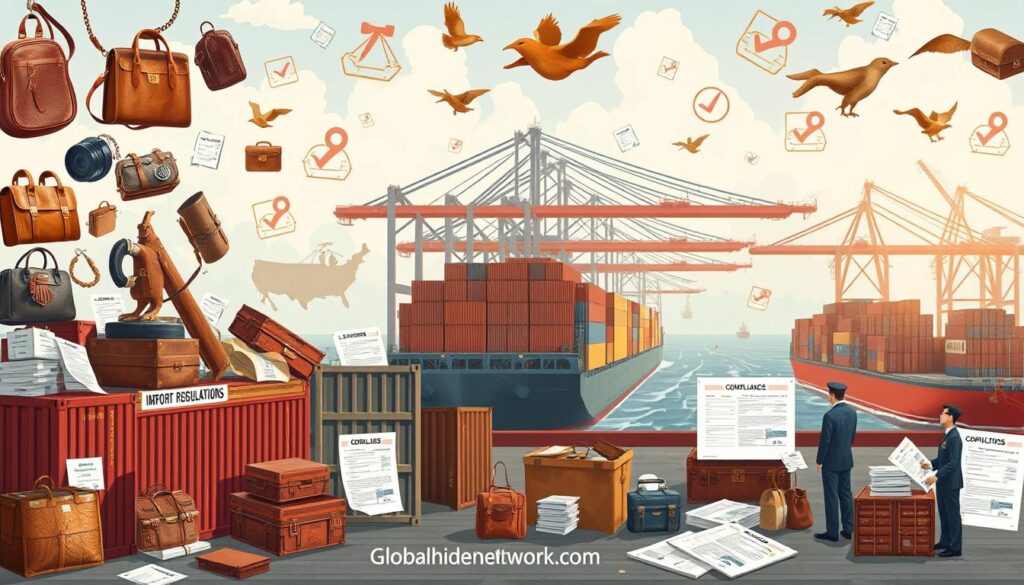Do you dream of starting a leather import business in the US? The market is growing fast. But, navigating international trade can be hard. Without the right research, you might miss great chances.
Don’t worry! I’ve got the key info you need. I’ll show you how to set up your business. We’ll cover market trends and customs rules, making your venture exciting.
The US leather import market is big and getting bigger. In 2020, we brought in $11.1 billion worth of handbags and $7.63 billion in shoes. China is the biggest exporter, sending $251 million in leather goods to the US.
But, countries like Cambodia are also making a splash. They increased their exports by 31.9% from 2019 to 2020. With the right trade approach and research, you can find your place in this booming field.
Key Takeaways
- The US leather import market offers diverse opportunities
- China is the top exporter of leather products to the US
- Handbags and footwear are major import categories
- Emerging markets like Cambodia show significant growth
- Proper market research is crucial for success
- Understanding customs regulations is essential
Understanding the Leather Import Market in the US
The US leather import market is lively and full of chances. The Leather Goods & Luggage Manufacturing industry is growing. It has seen a 1.5% CAGR over the last five years, hitting $3.5 billion in 2024. This growth makes it a great time to get into the market.
Types of Leather Products in Demand
Women’s handbags are the top choice in the US leather goods market. Footwear, apparel, and accessories are also popular. When looking for products, I must think about different leather types and tanning methods to meet what customers want.
| Product Category | Market Share | Popular Leather Types |
|---|---|---|
| Handbags | Largest segment | Full-grain, top-grain |
| Footwear | Significant | Genuine leather, suede |
| Apparel | Growing | Nappa, nubuck |
| Accessories | Diverse | Various finishes |
Top Exporting Countries for Leather Goods
China is the top exporter of leather goods to the US, even with higher tariffs. Vietnam and Cambodia are becoming more popular. They offer good prices and quality. It’s important to know the import rules for these countries.
Market Trends and Consumer Preferences
US consumers have different tastes. There’s a big interest in eco-friendly leather and special finishes like aniline and vegetable-tanned leather. Keeping up with these trends is essential for success in the leather import business.
Legal Requirements for Leather Import Business Setup
Starting a leather import business in the US needs careful legal steps. You must get the right licenses, follow customs rules, and handle import duties.
Obtaining Necessary Licenses and Permits
To start importing leather goods, you need the right licenses. Most leather from domestic animals doesn’t need special permits. But, exotic leather from wildlife needs a permit from the US Fish and Wildlife Service. This takes about 60 days and costs $100.
Compliance with US Customs Regulations
Understanding customs clearance is crucial. You must ensure all leather products are labeled correctly. This includes the country of origin and material content. The Federal Trade Commission has rules for leather and imitation leather in 16 CFR Part 24.

Understanding Import Duties and Taxes
Import duties and taxes change based on the product and its country of origin. You should check the Harmonized Tariff Schedule of the United States (HTSUS) on the U.S. International Tariff Commission website. Knowing these costs is key to a successful leather business.
| Requirement | Details |
|---|---|
| CPSIA Compliance | Mandatory for children’s products, costs ~$300 per item |
| California Prop 65 | Testing starts at $200, varies by product complexity |
| Labeling | Must include fiber content, origin, manufacturer, care instructions |
| Footwear | Disclosure required for imitation or artificial leather |
Sourcing Quality Leather Products
Leather sourcing is key for a successful import business. The quality of leather greatly affects your products’ appeal and value. Knowing about leather grades and types is essential for quality control.
Full-grain leather is the highest quality, followed by top-grain and genuine leather. I look at durability and appearance when choosing products. For international trade, it helps to work with reliable suppliers from countries known for quality leather.
Here’s a breakdown of leather exports from India, a major player in the global leather market:
| Year | Total Export Value |
|---|---|
| 2020-21 | $3.68 billion |
| 2021-22 | $4.87 billion |
| 2022-23 (Target) | $6.00 billion |
The USA is the biggest market for Indian leather products, making up 17.52% of exports. Attending trade shows is a great way to find suppliers and check product quality. It’s also important to make detailed RFQs to ensure quotes meet your needs.
The sampling process can take 2-4 weeks, and charges don’t include shipping. When buying from overseas, remember to add costs like duties, taxes, and transportation. Clear communication helps overcome language and cultural barriers with international manufacturers.
Navigating Import Regulations and Restrictions
Importing leather goods to the US is complex. The Federal Trade Commission (FTC) has strict rules for leather labels. This is to stop false claims. As an importer, knowing these rules is crucial for customs clearance.
FTC Leather Guides and Labeling Requirements
The FTC wants accurate labels on leather products. I must list material, origin, maker, and care on labels. These rules change based on the leather type, like clothes, shoes, or accessories.

Restrictions on Exotic Leather Products
Exotic leather imports have extra hurdles. I need special permits for these. It’s important to check the item’s legality and have all documents ready before shipping.
Handling Raw Leather Imports
Raw leather imports follow USDA rules. I must handle and process them correctly. This means proper packaging and documents to clear customs without issues.
Knowing these import rules is vital for success in the leather import business. By being informed and following the rules, I can avoid delays and penalties. This helps build a good reputation in the US market.
Establishing Your Supply Chain
Setting up a strong supply chain is essential for success in leather sourcing and international trade. I look for reliable suppliers in countries like China, Italy, and Vietnam. I check their production, quality control, and shipping skills.
Good communication is key in supply chain management. I work out terms that help both sides and track orders and inventory. This keeps my leather import business running smoothly.
Here’s what I focus on in my supply chain:
| Factor | Importance | Impact on Business |
|---|---|---|
| Supplier Reliability | High | Consistent product quality and timely deliveries |
| Production Capacity | Medium | Ability to meet demand during peak seasons |
| Shipping Capabilities | High | Efficient logistics and reduced transit times |
| Quality Control Measures | High | Minimized defects and customer satisfaction |
Diversifying my products has boosted sales and profits. Offering different leather goods attracts more customers. This strategy has been very rewarding for my import-export business.
Quality Control and Product Safety Standards
Quality control is key in the leather import business. I must make sure my products are safe and meet regulations. This means paying close attention to how leather is tanned and what types are used.
CPSIA Compliance for Children’s Leather Products
Importing kids’ leather items means following the Consumer Product Safety Improvement Act (CPSIA). I need to get third-party testing from labs that are approved. I’ll also have to make a Children’s Product Certificate (CPC) and use the right CPSIA labels.
California Proposition 65 Requirements
California Proposition 65 limits toxic substances in products. I must make sure my leather goods follow these rules to sell in California.
Implementing Quality Assurance Measures
To keep quality high, I’ll do regular checks on products and materials. This includes looking at different leathers and how they’re tanned. I’ll also check my suppliers to make sure quality stays the same.
- Physical testing of leather durability
- Chemical analysis for harmful substances
- Color fastness checks
- Flexibility and adhesion tests
- Flammability testing for safety compliance
By focusing on these quality control steps, I can make sure my leather products are safe and meet customer needs.
Customs Clearance and Logistics Management
Customs clearance is key in international trade. It’s not just about getting goods into a country. It’s about knowing the rules, having the right papers, and being ready for delays.
Working with a licensed customs broker can make things easier.
Supply chain management is also important. I have a plan for everything from shipping to storage and delivery. I track my shipments and manage my inventory well. This ensures my customers get their orders on time.
Here are some key points I’ve learned about customs clearance and logistics:
- Accurate information is crucial for customs authorities
- Some leather products may need special licenses or permits
- Product standards and certifications ensure quality and safety
- Establishing a good relationship with a local bank helps manage international transactions
Understanding these aspects has helped me run my leather import business better. It’s not always easy, but with the right knowledge, it’s manageable.
Marketing and Selling Imported Leather Goods
Marketing imported leather goods needs a lot of market research. The import-export sector is growing fast. Knowing about different leather types and tanning processes is important to attract quality customers.
Identifying Target Markets
I need to find my perfect customers. India is great at exporting leather products like wallets and handbags. I’ll look for buyers who value the craftsmanship of these items.
Developing a Unique Selling Proposition
Being unique is key in this competitive market. I’ll talk about the special features of my leather goods. This could be where they come from or the tanning process used. This can make my products stand out, even in a market full of gems and precious stones.
Creating an Effective Marketing Strategy
I’ll use both online and offline methods for my strategy. E-commerce sites and social media will help me reach more people. I’ll also go to trade fairs to meet manufacturers and retailers. By connecting with clients and keeping up with market trends, I hope to find my place in this exciting field.
